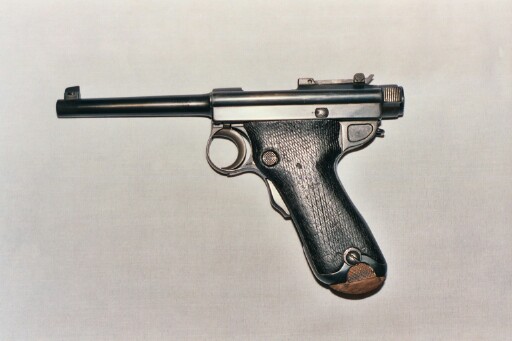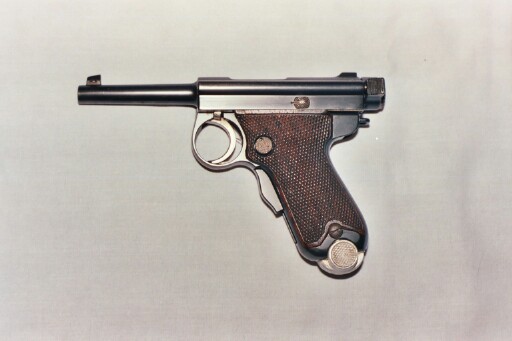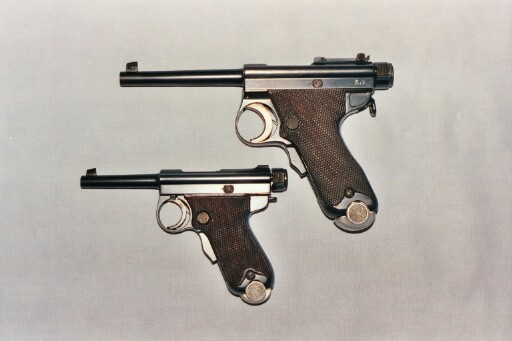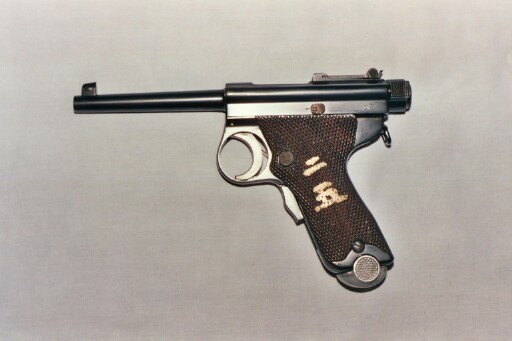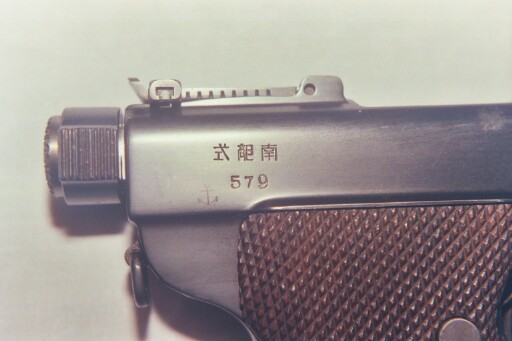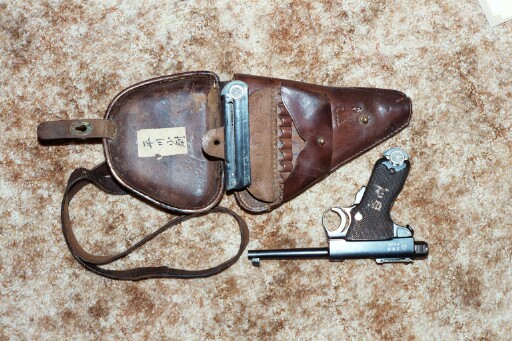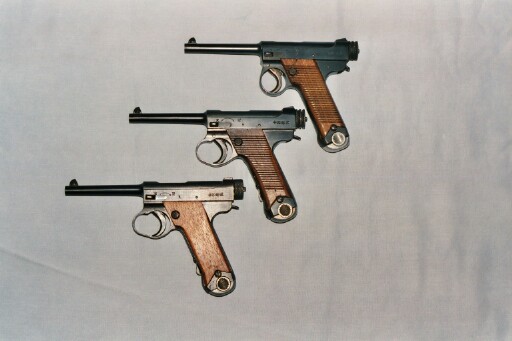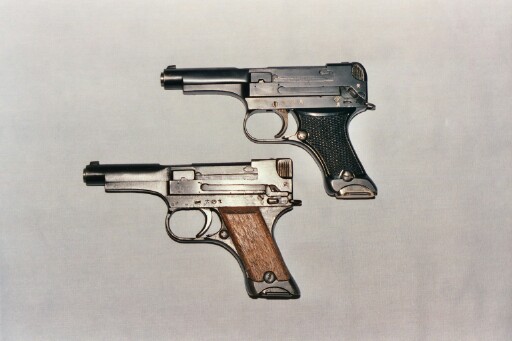Japanese
Nambu Pistols.
by Cliff Carlisle
Kijiro
Nambu was born Sept. 22, 1869. He entered the Japanese Army to pursue
a career as an arms designer. In early 1897 Capt. Nambu was assigned
to Tokyo Arsenal. He was promoted to Maj. and placed in charge of
the development of a semi auto pistol for the Japanese military.
In 1902 he had completed his design of an 8mm pistol. This was followed
almost immediately with a 7mm officer’s model & changes to his original
8mm design. These pistols are known to collectors as the Grandpa
(Model 1902), Baby & Papa (Model 1902 Modified). All 3 are marked
on the right side of the receiver with Nambu Shiki, which translates to
Type Nambu.
The Grandpa
is easily distinguished from the Papa by the very small trigger guard and
wood based magazine. All of these pistols are cut for a shoulder
stock and were originally issued with a shoulder stock holster. Less
than 2400 pistols were manufactured. Of the 130 recorded pistols
listed in "Hand Cannons Of Imperial Japan" 34 of them still have the shoulder
stock holster.
The 7mm
Baby Nambu was produced for private purchase by Japanese officers.
The pistol & cartridge are scaled down versions of the Grandpa.
It was expensive to produce. The Officers Union, where most of the
Japanese Officers equipment was purchased, listed the Colt M1903 &
Browning M1910 .32 acp pistols for 100 yen, the Baby was listed at 180
yen.
The Baby was produced
primarily by Tokyo Arsenal. Less than 6000 were produced there. Tokyo Gas
and Electric also produced Babies, but only about 550 of them. This
makes the TGE Baby one of the rarest Japanese pistols produced.
Baby Nambu shown
with a Papa Nambu for size comparison.
The Papa Nambu
(Model 1902 Modified) was produced by the Tokyo Arsenal and by Tokyo Gas
and Electric.
Tokyo Arsenal began
production in approximately 1906. Production ended with the adoption
of the Type 14 in 1925. Less than 4600 completed pistols were produced.
Though produced at an Army arsenal, it was never officially adopted by
the Japanese Army but was for private purchase by officers. In addition
to the Type Nambu markings on the right side these pistols have Riku Shiki
or Army Type stamped on the left. The markings on the grip of the
pistol shown is a rack number. It is 25 or the 25th pistol in the
unit it was assigned to.
Tokyo Gas and Electric
produced pistols with a 2-piece frame to eliminate some of the difficult
machining steps. Note in the photo of the Papa & Baby that the
Papa has a recess milled into the frame just behind the upper rear of the
grip. This is a 1-piece frame. This photo shows no recess and
it is a 2-piece frame.
The first of the
production of Tokyo Gas & Electric was for a 1500 piece Naval contract
in 1909. The initial pistols were cut for a shoulder stock but the
Navy changed its mind before delivery and had the stock slots filled at
the arsenal. During WW1 the Japanese Navy placed an additional order
for about 2500 guns. Though it was officially adopted by the Navy
& not by the Army, Naval documents refer to it as the Army Type pistol.
For the final production
of the Papa, Tokyo Arsenal shipped it’s remaining supply of parts, including
frames, to TGE. Starting with serial number 8000 (the highest recorded
S/N for a TGE with all TGE parts is s/n 4866) pistols were produced with
mixed parts from both manufacturers. The TGE logo is over the chamber
& the Tokyo Arsenal stacked cannon balls are on the right side of the
receiver. Less than 700 were produced with this combination.
Naval anchor
on early Tokyo Gas and Electric Papa Nambu. The WW1 order used an
anchor with a "v" shaped bottom instead of the rounded one.
Tokyo Gas
and Electric 8000 s/n range pistol with holster, strap & spare magazine.
The paper label inside the flap reads "Hirakawa Syo-i" or 2nd Lieutenant
Hirakawa. The veteran scratched into the holster "Chuck Rooney 37667933
158th, Camp Maxey Texas, Paris, Texas 158th Engin’s, 3rd Army and 1st Lt.
Japan Army 16 May 1945". The 158th Engineers were with the 3rd Army
at Bastogne. Apparently Chuck Rooney got around. After the
war ended in Europe he must have been sent to the Pacific.
By the early 1920s
the Japanese army realized that they needed a new pistol that was easier
& cheaper to manufacture. The development of this new pistol
was assigned to Tokyo Arsenal, which was under the command of General Nambu.
The new pistol was adopted in 1925, the 14th year of the reign of Emperor
Taisho. Hence the model designation Type 14. From 1925 through
1945 over 280,000 Type 14s were produced.
The initial production
was with a small trigger guard. Experiences in China in the mid 1930s showed
a problem with the small guard. A gloved finger couldn’t get into
the guard to fire the pistol. So the guard was modified by extending
it toward the muzzle creating a somewhat unusual appearance. These
are referred to by collectors as Large Trigger Guard Nambus. Toward the
end of the war additional shortcuts in production were taken such as not
grooving the grips & changing the cocking knob to make it round &
eliminate machining operations.
Type 14
pistols representing early, mid & late production. Even though
the late production pistol shown is in near new condition, the bullets
keyhole when fired indicating the poor quality control that was overtaking
Japan as the war progressed.
General Nambu retired
from the Japanese Army in December 1924 and established Nambu Rifle Manufacturing
Company, a private arms production company. In 1934, just after he
had started production of the Type 14 pistol in his plant, he was approached
by the army. They ask him to design a new smaller 8mm pistol for the use
of air crews, tankers & any other personnel that needed a smaller hand
gun than the Type 14. The final prototype was tested & adopted
by the army in late 1934 & designated the Type 94. 1934 was year
2594 of the Japanese calendar. Between 1935 (the first production)
& 1945 over 71,000 Type 94s were delivered to the Japanese military.
As with the Type 14 as the war progressed the quality of the Type 94 deteriorated.
The un-grooved grips were introduced in mid 1944. By 1945 the cocking
knob was no longer having the radius machined at it’s top. The resulting
pistols are referred to as "Square Back" types.
Type 94
pistols representing early and late war types. The lower pistol is
one of the 1945 produced Square Backs.
Another Nambu site:
http://members.shaw.ca/tju/jhg.htm
copyright Carbines
for Collectors 2003
|
